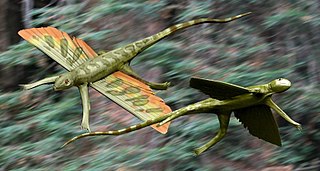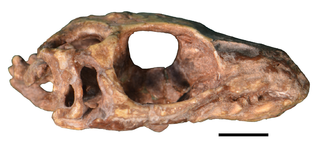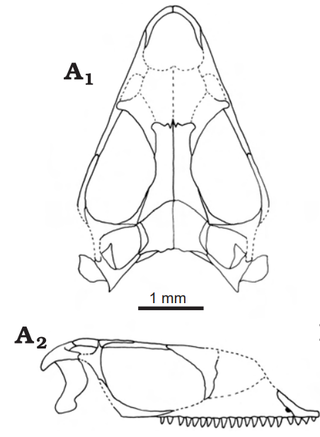
An anapsid is an amniote whose skull lacks one or more skull openings near the temples. Traditionally, the Anapsida are the most primitive subclass of amniotes, the ancestral stock from which Synapsida and Diapsida evolved, making anapsids paraphyletic. It is however doubtful that all anapsids lack temporal fenestra as a primitive trait, and that all the groups traditionally seen as anapsids truly lacked fenestra.

Mesosaurs were a group of small aquatic reptiles that lived during the early Permian period (Cisuralian), roughly 299 to 270 million years ago. Mesosaurs were the first known aquatic reptiles, having apparently returned to an aquatic lifestyle from more terrestrial ancestors. It is uncertain which and how many terrestrial traits these ancestors displayed; recent research cannot establish with confidence if the first amniotes were fully terrestrial, or only amphibious. Most authors consider mesosaurs to have been aquatic, although adult animals may have been amphibious, rather than completely aquatic, as indicated by their moderate skeletal adaptations to a semiaquatic lifestyle. Similarly, their affinities are uncertain; they may have been among the most basal sauropsids or among the most basal parareptiles.

Lepidosauromorpha is a group of reptiles comprising all diapsids closer to lizards than to archosaurs. The only living sub-group is the Lepidosauria, which contains two subdivisions, Squamata, which contains lizards and snakes, and Rhynchocephalia, the only extant species of which is the tuatara.

Kuehneosaurus is an extinct genus of Late Triassic kuehneosaurid reptile known from the Late Triassic of the Penarth Group of southwest England and the Steinmergel Group of Luxembourg. Temperature at this stage and region would have ranged from 28 to 35 °C. It was named by P. L. Robinson in 1962 in honour of paleontologist Walther Kühn, and the type and only species is Kuehneosaurus latus. Measuring 72 centimetres long, it had "wings" formed from ribs which jutted out from its body by as much as 14.3 cm, connected by a membrane which allowed it to slow its descent when jumping from trees. It is a member of a family of extinct gliding reptiles, the Kuehneosauridae, within a larger living group the Lepidosauromorpha, which contain modern lizards and tuatara.

Avicephala is a potentially polyphyletic grouping of extinct diapsid reptiles that lived during the Late Permian and Triassic periods characterised by superficially bird-like skulls and arboreal lifestyles. As a clade, Avicephala is defined as including the gliding weigeltisaurids and the arboreal drepanosaurs to the exclusion of other major diapsid groups. This relationship is not recovered in the majority of phylogenetic analyses of early diapsids and so Avicephala is typically regarded as an unnatural grouping. However, the clade was recovered again in 2021 in a redescription of Weigeltisaurus, raising the possibility that the clade may be valid after all.

Weigeltisaurus is an extinct genus of weigeltisaurid reptile from the Late Permian Kupferschiefer of Germany and Marl Slate of England. It has a single species, originally named as Palaechamaeleo jaekeli in 1930 and later assigned the name Weigeltisaurus jaekeli in 1939, when it was revealed that Palaeochamaeleo was a preoccupied name. A 1987 review by Evans and Haubold later lumped Weigeltisaurus jaekeli under Coelurosauravus as a second species of that genus. A 2015 reassessment of skull morphology study substantiated the validity of Weigeltisaurus and subsequent authors have used this genus. Like other Weigeltisaurids, they possessed long rod-like bones that radiated from the trunk that were likely used to support membranes used for gliding, similar to extant Draco lizards.

Drepanosaurs are a group of extinct reptiles that lived between the Carnian and Rhaetian stages of the late Triassic Period, approximately between 230 and 210 million years ago. The various species of drepanosaurid were characterized by specialized grasping limbs and often prehensile tails, adaptions for arboreal (tree-dwelling) and fossorial (digging) lifestyles, with some having also been suggested to be aquatic. Fossils of drepanosaurs have been found in Arizona, New Mexico, New Jersey, Utah, England, and northern Italy. The name is taken from the family's namesake genus Drepanosaurus, which means "sickle lizard," a reference to their strongly curved claws.

Mecistotrachelos is an extinct genus of gliding reptile from the Late Triassic of Virginia. It is generally interpreted as an archosauromorph, distantly related to crocodylians and dinosaurs. The type and only known species is M. apeoros. This specific name translates to "soaring longest neck", in reference to its gliding habits and long neck. This superficially lizard-like animal was able to spread its lengthened ribs and glide on wing-like membranes. Mecistotrachelos had a much longer neck than other gliding reptiles of the Triassic such as Icarosaurus and Kuehneosaurus. It was probably an arboreal insectivore.

Osmolskina is a genus of archosauriform reptile which lived during the Early Triassic in what is now Poland. The type species, Osmolskina czatkowicensis, was described by Magdalena Borsuk−Białynicka and Susan Evans in 2003. The generic name honors the late female Polish paleontologist Halszka Osmólska.

Eolacertilia is an extinct clade of lepidosauriform diapsid reptiles known from the Late Permian to the Late Triassic. It is uncertain as to whether they are a natural group and it has been suggested that they form a "waste basket" taxon. Currently, the only members of the group are Paliguana and Kuehneosauridae. Other genera were transferred to basal groups within Diapsida, Archosauromorpha.

Weigeltisauridae is a family of gliding neodiapsid reptiles that lived during the Late Permian, between 259.51 and 251.9 million years ago. Fossils of weigeltisaurids have been found in Madagascar, Germany, Great Britain, and Russia. They are characterized by long, hollow rod-shaped bones extending from the torso that probably supported wing-like membranes. Similar membranes are also found in several other extinct reptiles such as kuehneosaurids and Mecistotrachelos, as well as living gliding lizards, although each group evolved these structures independently.

Pamelina is an extinct genus of basal kuehneosaurid known from Early Triassic rocks of Czatkowice 1, Poland. It was first named by Susan E. Evans in 2009 and the type species is Pamelina polonica. It is the oldest known member of Kuehneosauridae. The vertebrae have characteristics consistent with gliding or parachuting.

Sophineta is an extinct genus of basal lepidosauromorph reptile known from the Early Triassic of Małopolska Province, southern Poland. It contains a single species, Sophineta cracoviensis.
Czatkowiella is an extinct genus of long-necked archosauromorph known from Early Triassic rocks of Czatkowice 1, Poland. It was first named by Magdalena Borsuk−Białynicka and Susan E. Evans in 2009 and the type species is Czatkowiella harae.
Susan Elizabeth Evans is a British palaeontologist and herpetologist. She is the author or co-author of over 100 peer-reviewed papers and book chapters.

Protorosauria is an extinct, likely paraphyletic group of basal archosauromorph reptiles from the latest Middle Permian to the end of the Late Triassic of Asia, Europe and North America. It was named by the English anatomist and paleontologist Thomas Henry Huxley in 1871 as an order, originally to solely contain Protorosaurus. Other names which were once considered equivalent to Protorosauria include Prolacertiformes and Prolacertilia.

Kuehneosuchus is an extinct genus of Late Triassic kuehneosaurid reptile known from the Late Triassic of southwest England. It was named by P. L. Robinson in 1967 and the type and only species is Kuehneosuchus latissimus. It is known from the holotype NHMUK PV R 6111, a set of associated vertebrae and ribs. It is a derived kuehneosaurid, most closely related to Kuehneosaurus. The genera are very similar and can be distinguished from one another primarily on the length of their "wing" ribs, relatively short and massive in Kuehneosaurus but up to 4 times longer and more gracile in Kuehneosuchus. However, the skull and major postcranial bones are identical in both taxa, as their age and horizon. According to aerodynamic studies Kuehneosuchus, unlike Kuehneosaurus which may be a species of the same genus or represent a different sexual morph, was probably a glider.

Marmoretta is an extinct genus of small lepidosauromorph reptile known from the Middle Jurassic (Bathonian) of Britain, as well as the Late Jurassic of Portugal. It contains a single species, Marmoretta oxoniensis.

Ozimek is a genus of sharovipterygid archosauromorph reptile, known from Late Triassic deposits in Poland and closely related to the Kyrgyzstani Sharovipteryx. It contains one species, O. volans, named in 2016 by Jerzy Dzik and Tomasz Sulej. Like Sharovipteryx, Ozimek had long, slender limbs with the hindlimbs longer than the forelimbs; the hindlimbs likely supported gliding membranes as fossilized in Sharovipteryx. Another unusual characteristic was the shoulder girdle, where the massive coracoids formed a shield-like structure covering the bottom of the shoulder region that would have limited mobility. In other respects, such as its long neck, it was a typical member of the non-natural grouping Protorosauria. Phylogenetic analysis has indicated that it, possibly along with Sharovipteryx, may have been an unusual member of the protorosaur group Tanystropheidae, although further study of its anatomy is needed to resolve its precise relationships.
Fraxinisaura is an extinct genus of basal lepidosauromorph reptile known from the Middle Triassic of Germany. The only known species is Fraxinisaura rozynekae. It possessed an elongated snout, unique features of the teeth, and an ilium which was intermediate in orientation between sphenodontians and squamates. Based on characteristics of the maxilla, it is considered a close relative of Marmoretta from the Middle Jurassic of the United Kingdom, resolving a ghost lineage between that genus and other Triassic basal lepidosauromorphs.

























